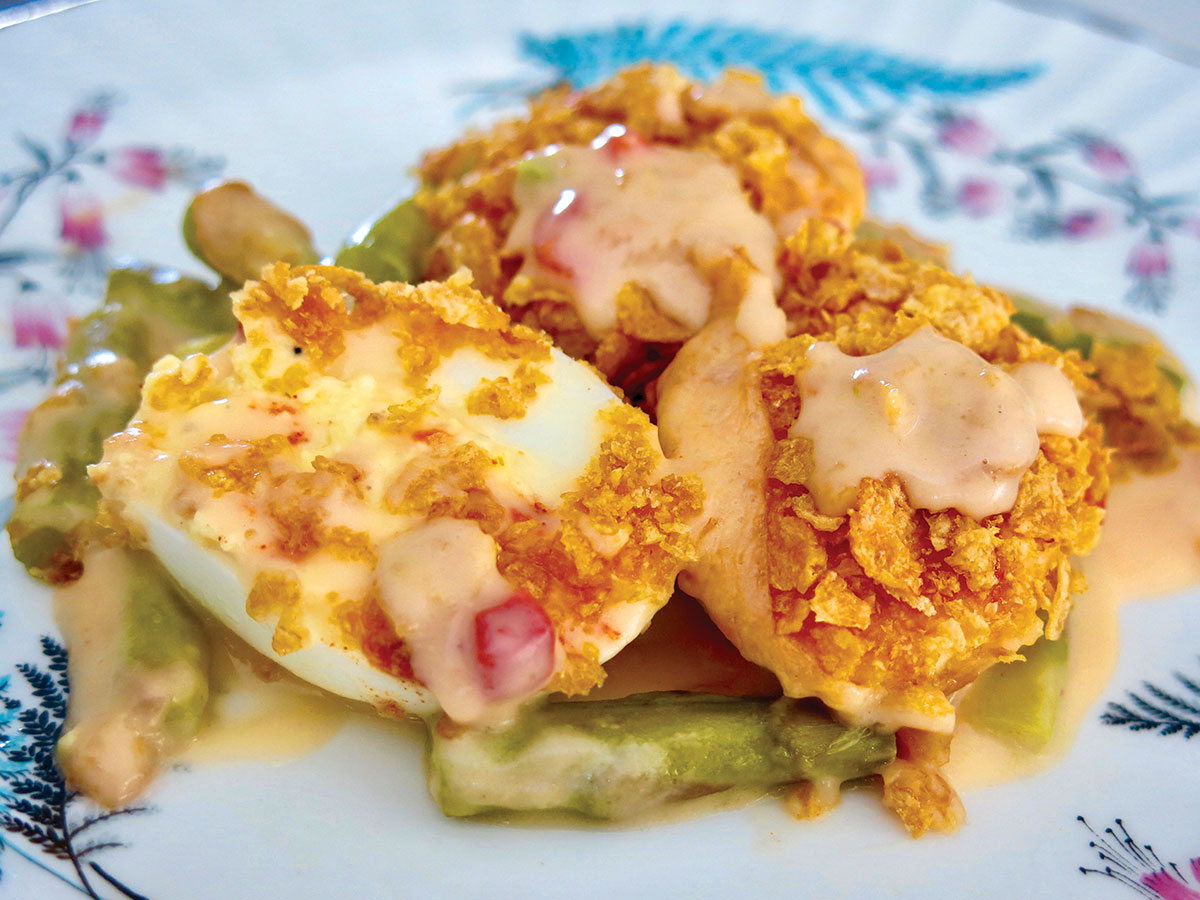
I’m a cookbook hoarder. Not modern cookbooks; I’m talking community and church cookbooks spanning the nineteen-sixties, seventies, and eighties. Most people today turn to the Internet for recipes—I turn to my coil-bound gems for the strange, the tasty, and the exotic. Well, as exotic as you can get with a Block Parent cookbook, from Melfort, Saskatchewan. I’m looking forward to serving up some rare treats here from days gone by, with the hope I might help a reader discover a new favourite dish.
I don’t know about you, but when summer hits, there’s nothing I like more than sliding on a thong, cranking up the rock ’n’ roll tunes, and lounging poolside while scarfing down devilled eggs. I’m not sure why I associate devilled eggs with summer. It could be because they were a staple at my family’s picnics. Our clan was serious about devilled eggs. Some of us even had special platters.
Devilled eggs, for those unaware, aren’t eggs possessed by Satan, but, rather, hard-boiled eggs sliced in two, with the yolks removed. The yolks are then mixed with other ingredients, like dry mustard and paprika, before being filled back into the halved egg whites. Devilled eggs, in spite of their elegance, seem to have fallen out of fashion, but maybe this recipe will change that. Fingers crossed, my friends. This recipe comes from The Beta Sigma Phi International Cookbook: Casseroles, published in 1969. It was submitted by Mrs. Anne Johnston, who was president of Beta Lambda No. 3357, in St. Catharines, Ontario. It’s a little time-consuming, between precooking the asparagus, hard-boiling the eggs, and making the cheese sauce, but just look at the results.
Devilled Eggs and Asparagus in Casserole
6 hard-cooked eggs
¼ teaspoon dry mustard
¼ teaspoon celery salt
2½ tablespoons salad dressing
¾ teaspoon salt
¼ teaspoon pepper
4 tablespoons butter
3 tablespoons flour
1½ cups milk
1 cup grated cheese
2 tablespoons minced pimento
1 pound cut asparagus, cooked
1 cup crushed cornflakes
Halve eggs lengthwise and remove the yolks. In a bowl, combine the egg yolks, mustard, celery salt, salad dressing, ¼ teaspoon salt, and pepper. Fill the egg whites with the yolk mixture. Melt 3 tablespoons of butter in a saucepan, and stir in the flour and remaining salt. Add milk gradually, stirring in the cheese until it’s melted, then stir in the pimento. Spread the asparagus in a greased 1½-quart casserole dish and arrange the eggs, cut side up, over the asparagus. Cover everything with the cheese sauce and sprinkle with cornflake crumbs and remaining butter. Bake at 350 degrees Fahrenheit for 20 minutes.
Mrs. Johnston didn’t say what kind of salad dressing, so I used mayonnaise. Also, there was no way I was paying three ninety-nine for a bottle of celery salt at No Frills for a measly one-quarter teaspoon, so I used garlic powder instead. I’m sure Anne would understand.
When it came to making the cheese sauce, Anne was a little light on the details, but I made something called a “Rue” (as in McClanahan), and whisked the mixture over medium heat until it thickened.
The result was delicious. The cheese sauce, paired with the crunch of the cornflakes and the tang of the devilled eggs sent me to summer heaven. Anne, you can have me over for dinner whenever you want. I’ll be the one on your doorstep wearing a thong.
[Correction: This recipe originally directed a baking time of three hundred and fifty degrees Celsius for twenty minutes. This will, in fact, result in a charred mess, and not the delicious summertime treat Brian intended. The correct temperature is three hundred and fifty degrees Fahrenheit. Taddle Creek takes full blame for this mistake, with no good excuse other than to say the magazine is new to this whole cooking thing. Taddle Creek regrets the error and any pool parties it may have ruined.]